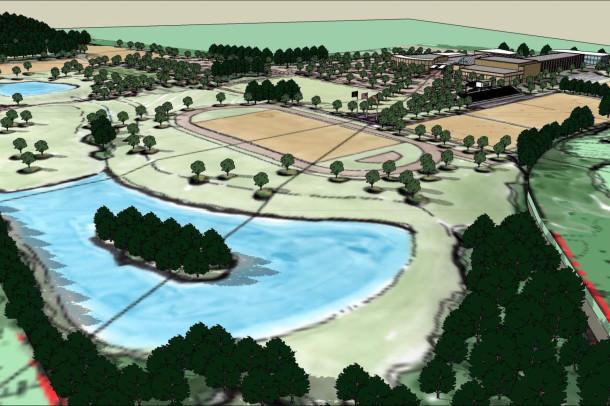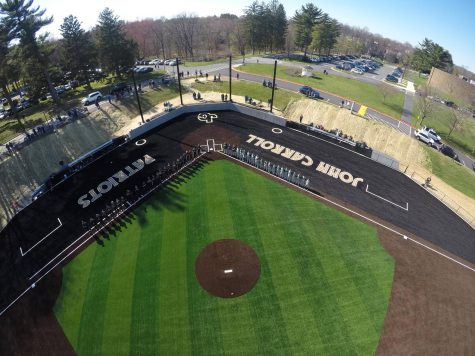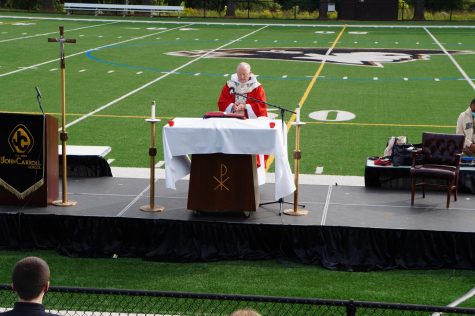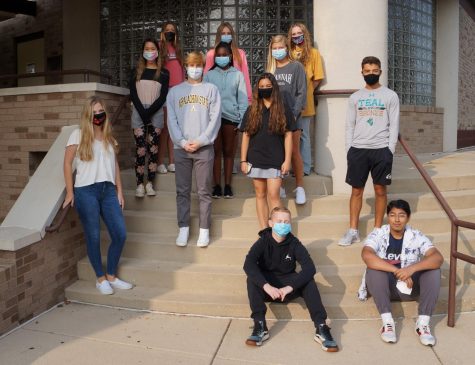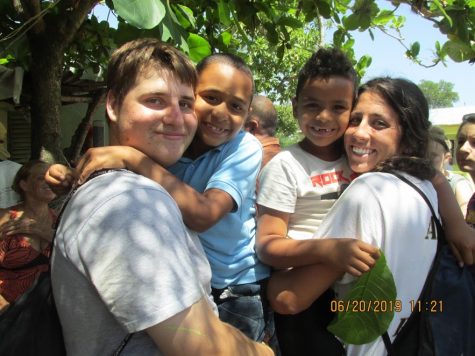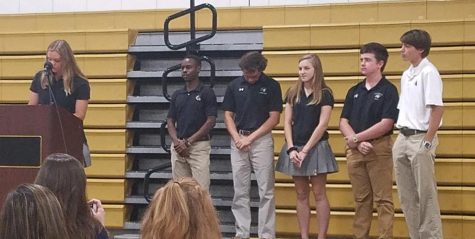$47 million plan begins with bathrooms
An artistic rendering shows new turf fields and other additions to the campus. The first phase of the Master Plan has a pricetage of about $14 million. The new bathrooms are part of the welcoming atmosphere JC is striving for. They cost the school approximately 352,000 and were partially funded by an anonymous donor.
As students enter and use the new bathrooms in the foyer, the price of that toilet is the furthest thought from their minds. However, those toilets, sinks, televisions, mirrors, and other improvements cost $350,000. They are part of a plan that is ultimately projected to cost $47 million.
According to President Richard O’Hara, the Master Facilities Plan, designed in2008, is estimated to cost $47 million and be completed in 12 to 15 years. So far 43 gifts, or donations, have been made to the project, adding up to approximately $1,550,890. Since 2008, no projects were completed until the recently renovated bathrooms in September 2012. The capital campaign, or fundraising for the Master Facilities Plan, has already started.
“I think the most important renovation is air conditioning because it’s really hot and [school] would’ve been better with it,” senior Brian Tenerowicz said.
The time since 2008 has been spent planning, fundraising, designing, obtaining permits, and receiving permission from the Archdiocese of Baltimore. O’Hara refers to this phase of the plan as “the quiet phase of the capital campaign.”
O’Hara says the campaign will go public next year and there will be “a lot more awareness of who’s being asked and who’s contributed [to the campaign].”
The $350,000 bathrooms were the first project of Phase One. Phase One includes the renovating the bathrooms, expanding the entry and exit way to have a third lane of traffic, renovating of the academic wing, installing air conditioning in the auditorium and cafeteria, getting turf and lights on the main field, and renovating the locker rooms. This phase alone will cost approximately $14 million. O’Hara said it is estimated that the school will raise $10 million of the $14 million and borrow the remaining four. According to O’Hara, the first phase is “hoped to be completed in the next five years.”
The bathrooms were selected as the first project, according to O’Hara, because they were identified in January 2012 as an accessible goal. By January, an alumni donor, whose name has not been released, offered to help fund the project. The donor requested to help with the bathroom project based on the nature of the donor’s company business, according to O’Hara.
“You go where the donors lead to a certain extent. It wasn’t like I believed in quality bathrooms my whole life,” O’Hara said.
“I like the new bathrooms. I use them a lot more, but I don’t think they were needed. Just put the money into athletics,” senior Austin Markely said.
According to Principal Madelyn Ball, the donor indicated interest in the bathroom project. Ball speculates that it had something to do with the relatively simple construction of the bathrooms.
“What do donors see most in this school? Bathrooms are a big congregating area. Everyone ends up in the bathroom at some point,” she said.
“It’s one of the first places everyone sees when they come into the building and it hadn’t been improved at all in 48 years,” O’Hara said.
Next on the agenda, according to O’Hara, is most likely adding air conditioning to the auditorium because it is “something we could handle financially and logistically.”
“Air conditioning in the auditorium and cafeteria might be next because it does not take that long to complete and we have some potential sources of funding there. $500,000 is not chicken feed, but neither is $6 million,” O’Hara said.
O’Hara says that the “highest priority” of Phase One is the renovation of the academic wing.
“To some degree, we are doing great things here educationally in spite of our facility and not because of it. That’s the bottom line,” O’Hara said.
The academic wing cannot be the next renovation because the money for the project, approximately six million dollars, is not raised yet. The schematic design for the renovation alone will cost an additional $250,000.
The renovation of the academic wing is also a major part of the recruiting process for enrollment, according to Ball and O’Hara. O’Hara says that new science labs, turf fields, locker rooms, and an air conditioned auditorium and cafeteria are “very real possibilities” for middle schoolers interested in attending JC.
O’Hara even feels that freshmen and sophomores have the possibility of benefiting from projects coming up in the new few years.
“I think for those coming in that are now freshmen and sophomores may well see another project or two during their time here… I think it’s feasible that in the next couple years that you would see the air conditioning and driveway],” O’Hara said.
“I feel like the bathrooms were fine, but it’s not like we hang out in there. I wish they had redone the cafeteria first, because that’s somewhere we hang out,” freshman Anna Martin said.
Beyond Phase One, the Master Facilities Plan aims to create a new stadium, new chapel, expand the auditorium to 1,000 seats, create a new cafeteria, new band and chorus rooms, a new academic learning center to house the library, and potentially add a new academic wing on top of the fine arts wing. The plan also discusses the reconfiguration of pieces of the campus overall, such as parking inside the oval, a new walkway to the new stadium, a roundabout with statue of Archbishop John Carroll in the center, an alumni gathering area, and a grotto, which can hold wedding ceremonies, by the ponds.
“I would like to think that would be completed in the next 20 years,” O’Hara said.
There is no set date or number of phases for these projects, because the total sum of money has not been raised yet.
“Most [donations] are five year pledges. [Donors] set a certain amount that they pay and mail their check in every year,” Vice President for Institutional Advancement Kurt Sudbrink said.
“When you’re trying to advance the school, you’re just going to be constantly in progress and fundraising mode,” O’Hara said.
According to O’Hara, Sudbrink and he have a list of prospects of potential donors that they call to try to solicit money. O’Hara says the past few years have been a lot of “working through our list and setting up meetings with people. O’Hara said his ideal goal would be to have 10 meetings a week with potential donors.
Ball believes the completion of the bathrooms will make a big difference in donations.
“It’s hard to get money from people if they don’t see that you’re investing in yourself. It’s like saying that we don’t believe enough in ourselves… Believe it or not, it makes a big difference to have those bathrooms done because it says to people ‘Okay they’re serious, they’re doing what they can. Now we have to help them to go to the next step,’” Ball said.
As for getting the needed donations from alumni, O’Hara doesn’t think it will be a problem. “If you believe in the mission of the school and the fact that you want to see JC be around in the next 5, 10, 15, 50 years this is what needs to happen to support it, otherwise we aren’t going to be able to compete. We have to move forward.”
Emily Clarke is the Print Chief for the Patriot and jcpatriot.com



